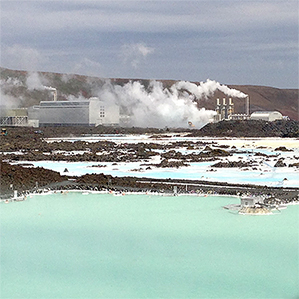Company Makes CO2 into Liquid Fuel, with Help from a Volcano
When a geothermal power plant started spewing hot water into the barren, volcanic landscape of Iceland’s Southern Peninsula in 1976, the locals turned the steaming lake into a health spa that’s now frequented by half a million people a year. Now a small Icelandic company is hoping to turn a profit from waste carbon dioxide from the same plant.

Carbon Recycling International has built an adjacent plant that converts the carbon dioxide into methanol, a fuel and feedstock for making plywood, paints, and other products. It may be the first company anywhere to demonstrate a commercially viable way of making liquid fuel directly from carbon dioxide, something that could help reduce greenhouse gas emissions.
So far, though, the economics work only in rare places that have cheap power and cheap carbon dioxide. For carbon dioxide recycling to make a big dent in emissions, we’ll need breakthroughs in catalysis and almost certainly a tax on emissions of carbon dioxide to provide an incentive to capture and use it.
In Iceland, industrial prices for electricity are only four cents per kilowatt-hour, roughly a third of what industry pays in Germany or in New England in the United States.
The carbon dioxide emitted by the geothermal plant is also cheaper to capture than the carbon dioxide from fossil-fuel power plants. At coal-fired plants, carbon dioxide is a product of burning coal in air—the resulting flue gas, like air, is mostly nitrogen, and separating the carbon dioxide is expensive.
Geothermal plants are powered by water heated by hot rocks underground, often those associated with volcanoes. Carbon Recycling brands its methanol Vulcanol, says CEO K-C Tran, because “it’s made with energy from a volcano.” Carbon dioxide is formed by the decomposition of underground carbonate rocks. The amount of carbon dioxide is relatively small—roughly one-20th as much as for coal-fired power plants per kilowatt-hour of electricity. But the geothermal plant emits highly concentrated streams of carbon dioxide that require less energy and equipment to separate and capture.
To make methanol from carbon dioxide, you need a source of hydrogen, since methanol is partly made of hydrogen. Hydrogen is also a fuel in its own right and provides the chemical energy needed to form methanol. Carbon Recycling gets its hydrogen by using electricity from the geothermal power plant to split water. Tran says that the process will be profitable by next year, when its five-million-liter methanol plant is operating at full capacity.
As the company thinks about expanding beyond Iceland, it is looking for other niches. The economics might work, Tran says, in places like Germany, where environmental policies have led to a glut of wind-generated electricity at night (see “Audi to Make Fuel Using Solar Power”).
Meanwhile, researchers are looking at other ideas for making carbon recycling profitable. Matthew Kanan, a professor of chemistry at Stanford, is developing catalysts that decrease the amount of energy required to turn carbon dioxide into useful chemicals, and also make it possible to produce chemicals more valuable than methanol, such as the chemical feedstock propanol. He says that with the price of electricity in Iceland, he could make a ton of propanol (which sells for about $3,200) with less than $800 of electricity.
The market for propanol, however, is relatively small. To make large-scale production of liquid fuel from carbon dioxide profitable, researchers are also turning to biology and genetic engineering (see “Making Diesel from CO2 and Sunlight”). Or they’re concentrating sunlight to heat catalysts up to extremely high temperatures to facilitate the reactions (see “Demonstrating a CO2 Recycler”). But biological approaches remain costly for now, and systems that use very high temperatures are prone to break down.
Technology alone probably won’t be enough to make fuels from carbon recycling viable, Kanan says. For fuel made from carbon dioxide to become widespread, governments will likely have to make it more expensive to emit carbon dioxide. “You can’t compete with oil out of a well,” he says.
Keep Reading
Most Popular
Large language models can do jaw-dropping things. But nobody knows exactly why.
And that's a problem. Figuring it out is one of the biggest scientific puzzles of our time and a crucial step towards controlling more powerful future models.
The problem with plug-in hybrids? Their drivers.
Plug-in hybrids are often sold as a transition to EVs, but new data from Europe shows we’re still underestimating the emissions they produce.
Google DeepMind’s new generative model makes Super Mario–like games from scratch
Genie learns how to control games by watching hours and hours of video. It could help train next-gen robots too.
How scientists traced a mysterious covid case back to six toilets
When wastewater surveillance turns into a hunt for a single infected individual, the ethics get tricky.
Stay connected
Get the latest updates from
MIT Technology Review
Discover special offers, top stories, upcoming events, and more.